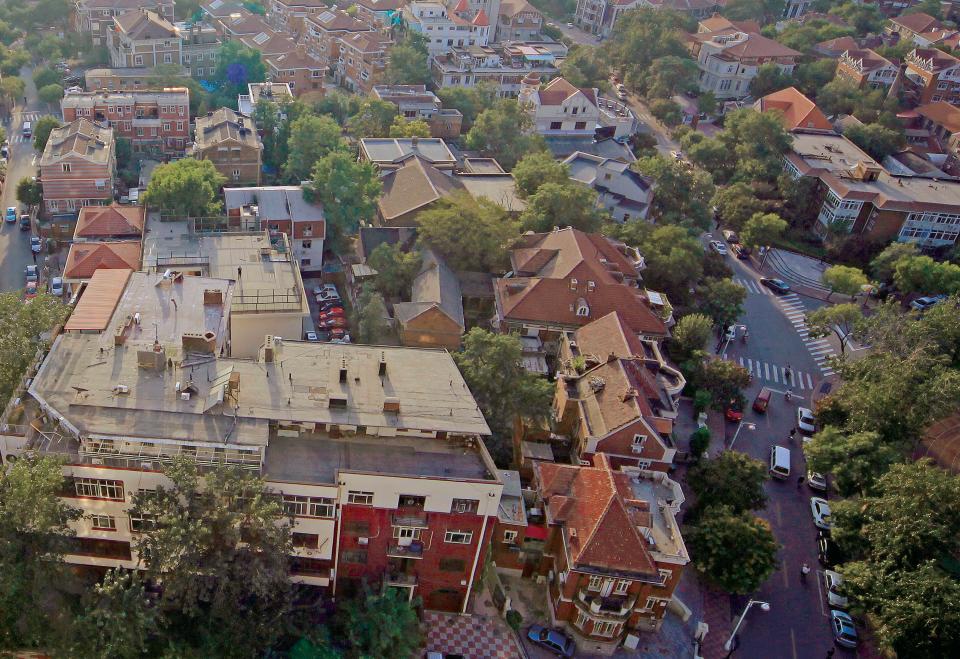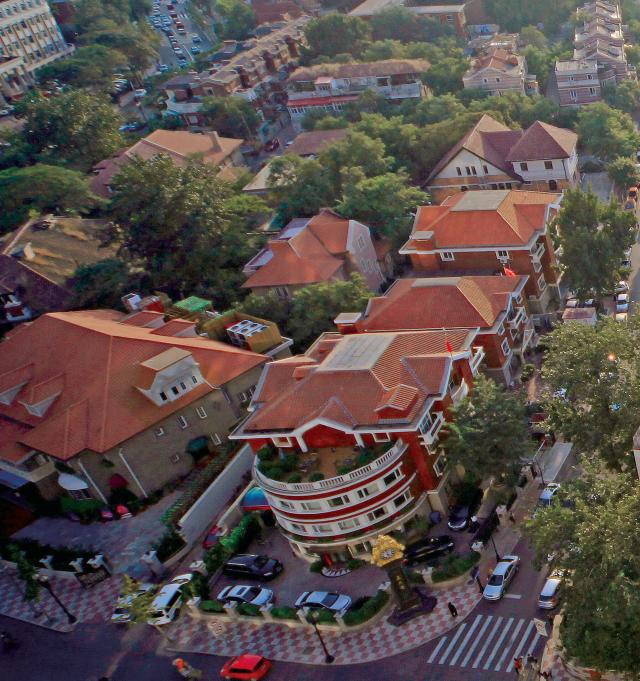In 2007, an eccentric cultural relics collector placed the last of hundreds of millions of shards of Chinese porcelain into the surfaces of a century-old French mansion in one of China’s major port cities, Tianjin.
The construction is a perfect metaphor for the city itself. Its foundation stands on Chinese soil, yet its flesh and bones are French, as it was built while the area was part of the city’s French concession. Then, not long ago, Chinese workers blanketed its exteriors with whole and partial Chinese ceramics, each with a history of at least 200 years, according to the project’s offbeat architect. It is a piece of colonized history, repurposed with a Chinese face.
And that’s Tianjin. It has been stamped with the characteristics and cultures of the nine countries that once established concessions within its city borders. Now that those countries are gone, locals have repossessed the vestiges of foreign power and tried to make them Tianjin’s own.
Between 1860 and 1902, Great Britain, the US, France, Germany, Japan, Russia, Italy, Austria-Hungary and Belgium sequentially portioned off local land, with the last holdout retaining its concession until 1947.
They built their own schools, operated their own prisons and collected their own taxes.
As a result, Tianjin is transporting. A walk through the city center is a global expedition.
Tiny Parisian alleyways branch off from a stall-lined pedestrian street. Wall Street bank columns shoot out of sidewalks. London row houses cozy up behind intricate wroughtiron gates. But everything is slightly off. The alleyway stalls sell selfie sticks, not French handicrafts. The columns bear the characters for Bank of China, not the name of a Wall Street giant. And out of one of the chestnut row houses that would look at home on the set of Sherlock emerge two Chinese women, languidly hanging pink cotton bedsheets on an undeniably Chinese clothesline. Tianjin is a smaller version of its colonial big sister, Shanghai. It is the embodiment of what happens when East literally meets West.
Porcelain House While Tianjin is not typically an international destination in itself, it is the perfect weekend or even day trip away for Beijing tourists. High-speed trains headed for Tianjin leave the capital every few minutes during peak hours, and passengers sit for just over half an hour before disembarking in the port city. At 54.5 yuan (US$8.42), an economyclass train ticket costs less than a mid-range meal.
Take Tianjin by foot. It’s the best way to drink in the discord. Right in front of the train station, the Haihe River unwinds itself as locals fish from above with nets affixed to six-meter-long bamboo poles. A steel bascule bridge lords over the river just steps southwest. Originally built by the French concession government in 1927, the bridge was originally dubbed Bridge of Ten Thousand Countries, but was renamed Liberation Bridge in 1949.
A short stroll through the northern part of the French concession leads to the aforementioned Porcelain House. The structure is a museum open to the public for 35 yuan (US$5.41). Often compared to works by Gaudí, the building’s facade is a chaotic collage of porcelain-drenched walls, vase-tiled roofs and unexplained, serpentine limbs that curve around the house like porcelain-scaled dragons. Even the handicapped bathroom’s wheelchair icon is marked in the material. Inside the mansion, detailed porcelain mosaics of twisting carp, crowing roosters and Yuan Dynasty (1271-1368) calligraphers decorate the walls. The entire museum seems to have been constructed for the purpose of illustrating the word “quirky.” Five Great Avenues A 30-minute walk south from the Porcelain House brings you deep into the former British concession. Unlike street-side shops in other Chinese cities, Tianjin’s stores don’t hang signs that are blocks of color, screaming out to passersby with three-feet-high font. All of their signage blends more into the background, heightening the feeling that you’re walking down a London residential street instead of a Tianjin tourist attraction.
But that’s what Tianjin’s Five Great Avenues is now. The five boulevards, originally labeled with names like Edinburgh and Cambridge, now mainly bear the names of Chinese cities.
Edifices exemplifying European architecture of all sorts sprang up in this area during the 1920s and ’30s. It attracted many wealthy Chinese, so dozens of homes here wear placards with the names of their famous former occupants, ranging from war heroes to toplevel politicians. It’s a 1.28-square-kilometer architectural museum.
At the Five Great Avenues’ heart is Minyuan Plaza, a huge stadium with a public track and turf area where older couples power-walk together and families toss Frisbees. Originally built in 1920, this newest incarnation opened its doors in 2013. Just like the Five Great Avenues area as a whole, the stadium is a symbol of a foreign power, reappropriated by Tianjin’s government and repackaged as a tourist attraction.
‘Italian Style Town’ The Italian concession stretches north of the Haihe River. Marked by expansive roundabouts and statues of figures like Dante Alighieri, one section of the former concession, branded as “Italian Style Town,” is now a remodeled shopping and restaurant district riddled with tiny alleyways and pedestrian-only avenues. What once was an Italian community has been painted over with Chinese features. Street vendors hawk souvenirs, Tianjin postcards and in-vogue accessories aimed at a Chinese crowd. A pair of caricaturists set up easels to display their best sketches of Chinese celebrities. Tuk-tuk drivers idle next to a stall selling seafood fried rice, hoping a tourist will climb aboard for a guided tour of the district.
Tianjin Eye The walkway running alongside the Haihe River is perfect for runners or couples taking wedding photos (we spotted two). Walk a few kilometers along the path, heading northwest from the Italian area, and soon you’ll spot the Tianjin Eye rising out of the water. The 120-meter-tall colossal Ferris wheel straddles the river and dwarfs most surrounding buildings. Aim to arrive just as the sun is about to set and get in line quick; staff members cut off the line as early as half an hour after sunset, depending on how quickly they fill the queue. The line may take an hour and a half and the ticket prices are steep (80 yuan [US$12.30] per person, 400 yuan [US$61.49] to book an entire gondola), but the night view of the city unveiling in front of you is exceptional. The red glow of the Tianjin Eye itself reflects off the windows of neighboring buildings while skyline lights shimmer off the Haihe River. The half-hour ride goes by all too quickly.
Tianjin Museum The Tianjin Cultural Center is a beautifully laid out complex of museums and exhibition centers, all of which face a sheet-like expanse of water that mirrors their dramatic architecture.
Next to the graceful curved crescent of the Tianjin Natural History Museum looms the Tianjin Museum, an imposing rectangular block and the largest museum in the city.
While many visitors come for the displays of cultural relics, calligraphy and porcelain wares, the museum’s detailed exhibits on Tianjin’s history merit more recognition. The first-floor one begins with the first signs of human life in Tianjin and works up to the late 19th century. It explores the city’s roots, Opium War experiences and basic industries at a time when Tianjin’s population had yet to reach a quarter of a million (it now exceeds 15 million). But the museum’s real jewel is the third-floor exhibit titled “One Hundred Years in Tianjin.” It documents the city’s history with concessionaires, a short-lived provisional government, the Boxer Rebellion and the Second Sino-Japanese War (1937- 45), ending with a display of the first fivestar Chinese flag flown in Tianjin after the founding of the People’s Republic of China in 1949. The content is one-sided, but it’s a side not often seen by Western eyes. The comprehensive photos, decent English translations and unique content all make this museum a must for any tourist looking to better understand Tianjin’s past before crossing back over Liberation Bridge, buying a train ticket and hurtling back to Beijing.

 Old Version
Old Version
